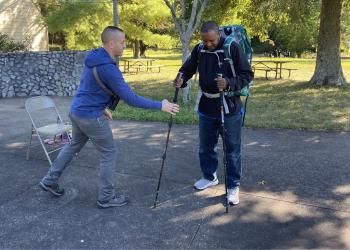Refugees Experience Hoosier National Forest
Contact Information: Quentin Melson, Public Affairs Specialist quentin.melson@usda.gov
U.S. Forest Service employees at the Hoosier National Forest recently joined forces with the non-profit organization, Common Earth Gardens, to provide refugees of war-torn nations a chance to connect with nature.
Earlier this month, a diverse group of more than 20 resettled refugees met with forest employees at the Tipsaw Lake Recreation Area in southern Indiana to learn about public lands, what opportunities they provide, how to prepare for a hike, and how to minimize impacts through Leave No Trace guidelines. The new forest visitors came from all over the world.
“It was great to have visitors from Burundi, Somalia, Sudan, Iraq, Afghanistan and Burma,” said Hoosier National Forest economic partnership coordinator, Cheryl Coon. “It was a great cross- cultural event for everyone.”
In addition to hiking principles, the trip to the Tipsaw Lake Recreation Area also included classes on camping techniques (with an emphasis on Leave No Trace principles) and recreational opportunities available on public lands.
“I enjoyed the trip to the Hoosier National Forest very much,” said Muhammad Hassan, a recent immigrant from Somalia. “I’ve never been to a national forest. I didn’t know about all of the opportunities available. Now, I’m looking forward to coming back with my family and hiking along the trails.”
Hassan’s lack of experience regarding public lands was not unique. As new United States residents, many of the immigrants were unaware of what public lands were or even where they were located.
“Being able to share the benefits of access to public lands to newly arrived citizens is huge,” said Common Earth Gardens Director, Jane Evans. “Many newly arrived citizens don’t have a good enough grasp of the English language to fully understand what public lands are and the benefits that they are entitled to.”
The event was made possible by a grant from the Forest Service’s Urban Connections program. Urban Connections is an Eastern Region Forest Service program that aims to connect urban and underserved communities with outdoor opportunities.
The program began in 2001, when Eastern Region Forest Service employees realized that while much of the region’s population lived in urban areas, community members had little awareness of public lands and lacked opportunity to be involved with management of their national forests. For newly arrived immigrants in urban areas, like Louisville, the lack of knowledge was even greater.
This underserved segment of the population was on Coon’s mind when Urban Connections funding became available last year.
“I had spoken with Jane Evans in early 2023 when her contact info was forwarded by a colleague,” said Coon. “We agreed to contact each other if we had any ideas on collaboration. When I saw the Urban Connections funding opportunity, I immediately thought of Jane and called her. We came up with our grant proposal idea, submitted it and was funded. The funding is for two years, bringing refugees onto the Forest two times a year (2024 and 2025).”
The Urban Connections joint project between Common Earth Gardens (an organization that seeks to increase land access to grow food, develop new farm businesses and build healthy community networks) and the Hoosier National Forest will continue later this year when refugees visit the forest again to learn about local ecosystems, local plant and wildlife species, and how these species and ecosystems are managed by the Forest Service.
Hoosier National Forest employees found the visit to be beneficial in many different ways.
“I think it was a success,” said Coon. “Both the forest visitors and [Hoosier] personnel enjoyed the beautiful weather and learned from each other.”
Evans was grateful for the many leisure activities that the newly arrived United States residents discovered were available to them.
“Even if our newly arrived people don’t come back and go camping, they now know they have a place to fish or trails to walk where they can pick persimmons and paw paws,” said Evans.



